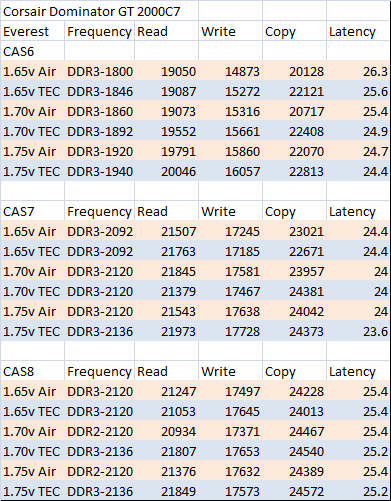Corsair Cooling Ice T30 TEC Memory Cooler Review
Test Results


I have provided two batches of results to help form a conclusion when evaluating the T30 memory cooling system. The first chart simply shows what was considered to be the maximum stable frequency for each CAS and voltage option. It should be noted that frequently I could boot into Windows at much higher speeds, so don’t take these values as the absolute maximum frequency possible. The CAS7 and CAS8 results aren’t all that interesting as I was uncore limited due to my Xeon 3570 having trouble past ~4200MHz uncore on air cooling. CAS6 though makes up for this in showing both the voltage and cooling scaling of the Dominator GT 2000C7 modules. Comparing the voltage and cooling scaling you could say the TEC module is worth a .03v overvolt. By this I mean to match the maximum frequency at 1.65v with the T30 you would need roughly 1.68v on air and the same seems to go with 1.70v and 1.75v. Unfortunately it has been so humid here in Atlanta the last two weeks that I haven’t been able to work up the courage to run the TEC in the unmetered mode but I suspect we’d see large jump pulling the memory modules down below 0 Celsius versus the ~16 Celsius they were at for the T30 testing.
The second chart is the average of each Everest run for each setting. Since Everest is affected by the smallest of activity the results are only useful for making general observations. Due to the uncore limitations CAS7 appears to offer the best bandwidth with the best latencies. Things could get very interesting with the CPU cooled better and vdimm increased to 1.8v or 1.9v as that might give CAS6 enough to put up a good fight.

Comments are closed.